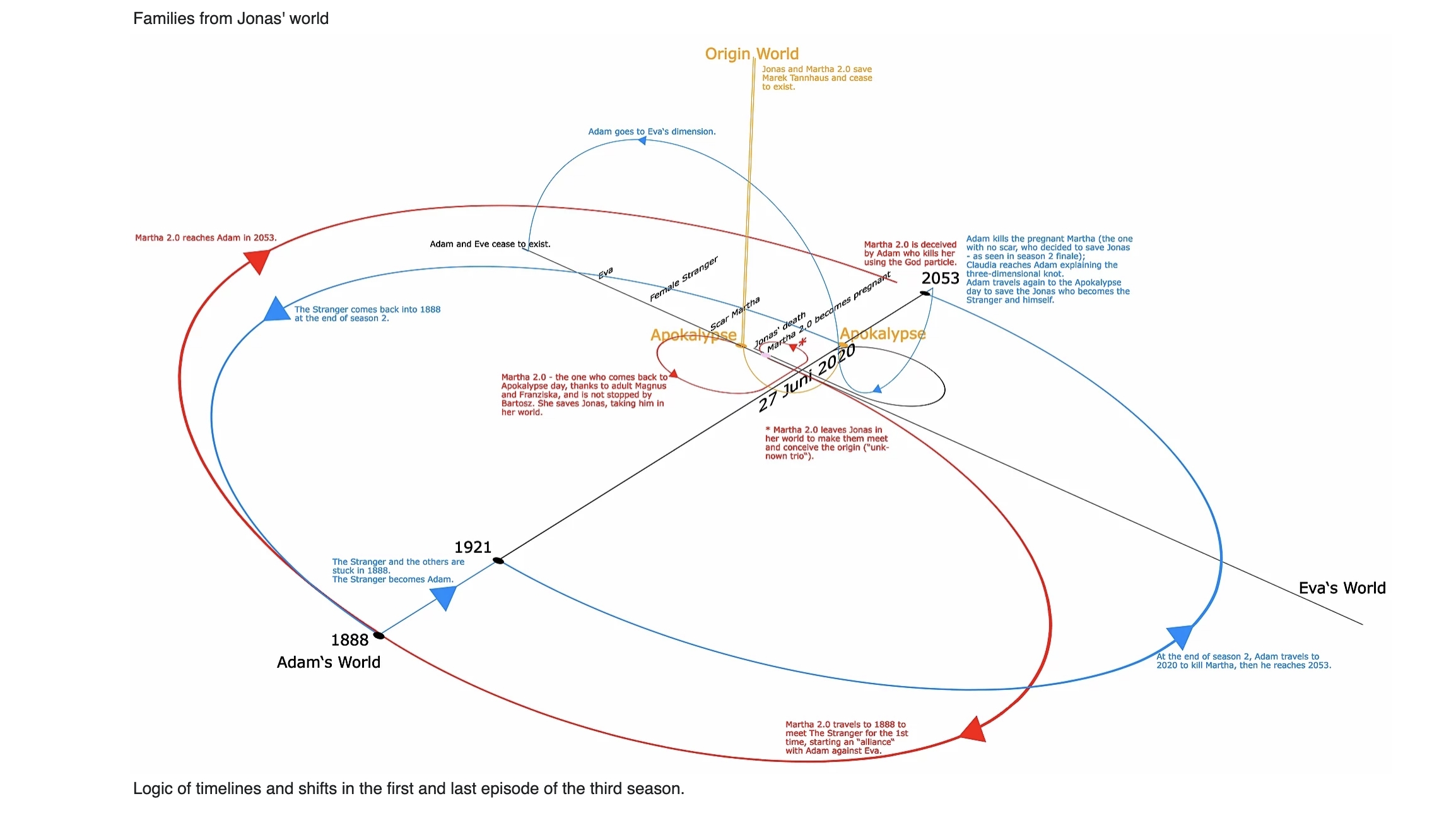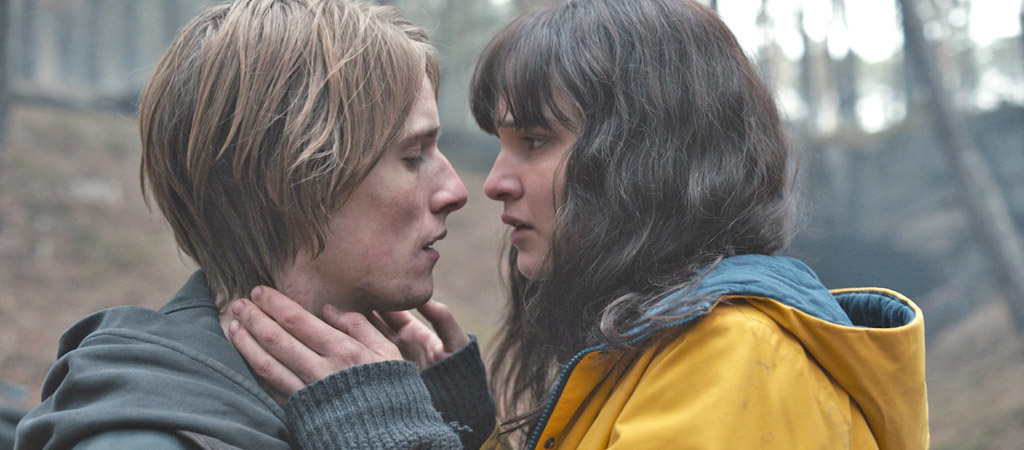WARNING: Spoilers for the entirety of Netflix’s Dark will be found below.
Dark, Netflix’s first ever original German series, finally wrapped up a three-season run with a mind-blowing, twisty, confusing, and ultimately satisfying third season. Over the course of those three seasons, Dark quietly found a sizable worldwide audience and a passionate critical following, scoring rave reviews and deserved comparisons to Twin Peaks and Stranger Things. The series has also been marked by confused viewers, attempting to hold the family trees intact in our minds as characters jumped back and forth in time and, eventually, between two different worlds.
After the first season, viewers needed a family tree (see it here) to keep up. By the third season, the family tree itself was as confusing as the series.

Trying to make sense of the quantum entanglement in the third season is a fool’s errand, and at a certain point, one wonders whether creators Jantje Friese and Baran bo Odar could keep it even in their heads any longer. By the third season, the series was playing mostly in a parallel world, one where Jonas was never born, which obviously meant a different composition of people, and yet, major events still continued to unfold as they did in Jonas’ world.
Season three is a complicated maze, referred to often as a knot, which is the best way to explain it. It’s an infinity symbol that gets tangled in numerous knots, so that older versions of characters who died when they were young are still alive, seemingly defying the rules of time travel. That is eventually explained, in episode six, where we learn that the main characters — Jonas and Marta — are trapped in an infinite loop, and even death doesn’t end the loop, because the characters can simply travel the loop in reverse. Moreover, because everyone’s fate is already fixed, Jonas cannot kill himself and remove himself from the loop, even though Marta had already killed him once. Jonas, meanwhile, had successfully killed the Marta in his world, but most of the events in the third season revolved around the Marta from the world in which Jonas never existed.
Got it? It’s very confusing, and each episode in season three seems to end with another revelation that creates yet another time paradox. However, the important takeaway from not just season three, but every episode up until the end is this: No matter what Jonas and Marta did in either world, the apocalypse would arrive and Jonas and Marta would eventually become Adam and Eva. Adam spent the entire series trying to wipe himself from existence in the hopes of finding himself in a paradise of nothingness. Marta and her allies, meanwhile, spent all of their travels trying to stop the apocalypse that destroyed both worlds.
In the end, both sides kept repeating themselves, and no matter how many times they traveled the loop, it would always end the same way. Every decision they made would lead them to the same place: The apocalypse would wipe out both worlds, but neither Adam nor Eva would die. From what we gather, this same pattern continues to repeat itself hundreds of times until Claudia finally figures it out: Jonas/Adam and Marta/Eva are trapped in a triquetra knot that originated outside of both of their worlds. WHAT?
Basically, what happens is this: A grieving H.G. Tannhaus — the clockmaker from the first season — created a time machine in an effort to undo the death of his son, daughter-in-law, and grandchild. The time machine malfunctioned, splitting his world into two: Jonas’ world and Marta’s world. Neither of their worlds are supposed to exist, but Marta and Jonas’ love for one another basically keep these two worlds intact, traveling their infinite loops between roughly 1890 and 2050. It is, therefore, on Marta and Jonas to return to the original world to prevent the son and daughter-in-law of Tannhaus from dying in a car accident, thus removing Tannhaus’ need to invent a time machine. Without the time machine, the worlds of Jonas and Marta never exist, and neither do Marta and Jonas (or most of the other characters in Dark), who can finally achieve their Paradise of nothingness.
However, those two worlds do have a small impact on the origin world: Marek, the son of Tannhaus, names his child Charlotte — an orphaned girl raised by Tannhaus in the other two worlds — and Hannah, who is married to someone else completely in the origin world, still names her child Jonas after an intense episode of deja vu.
Still, the final season is a mess of fits and starts, dead-ends and deaths, none of which ultimately matter because most of these characters will not exist in the end. Even the final episode is 25 minutes of exposition, as Claudia tries to make sense of and explain the origin world to Adam/Jonas. There’s very little character development — or even much of a story — in the final season. It mostly amounts to characters traveling back and forth through time in two different worlds and never accomplishing anything, which is by design.
Moreover, the introduction of a third, “origin world” in the final episode almost feels like a Deus ex Machina — one that will eventually wipe out nearly every event in the first three seasons — but ultimately it works to satisfying affect because of the emotional bond built between Jonas and Marta in the first season before the two turned on each other. It might have otherwise felt cheap to suggest that these two bastard worlds continued to exist on an infinite loop because of “love,” except that Dark spent three seasons ensuring that the love between Marta and Jonas was intense and believable, so that when they finally do disappear — in all the various timelines — it’s a bittersweet and satisfying relief. It’s such a sweet emotional conclusion that, even after spending three seasons characters who will be rendered nonexistent, I did not feel cheated.
It’s not about the destination, as they say, it’s about the journey, and this journey was a marvelous roller-coaster ride through numerous timelines and two different worlds, all of which would eventually be wiped from existence, while the characters continue to live happily ever after in nothingness.
Netflix’s ‘Dark’ is currently streaming.







